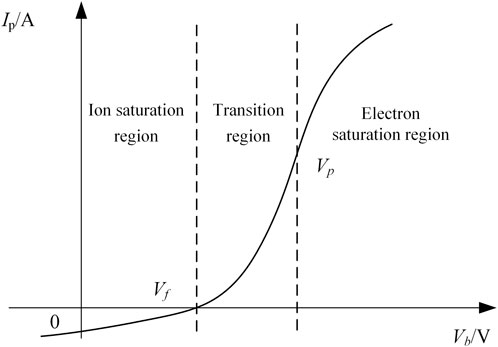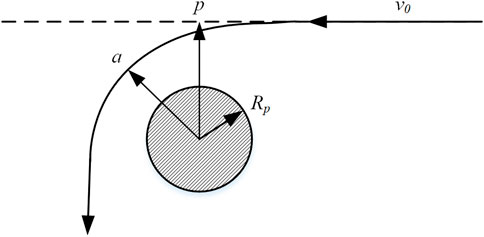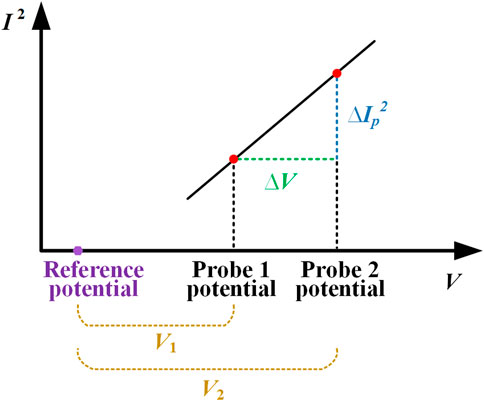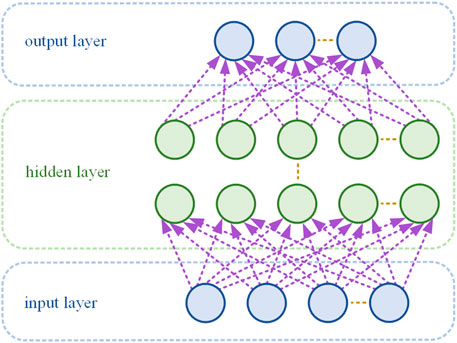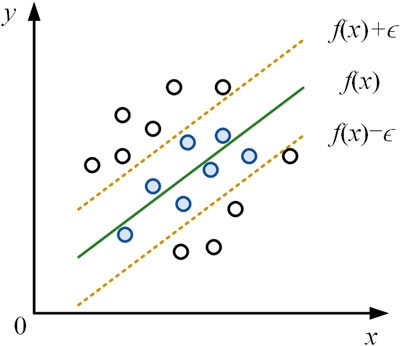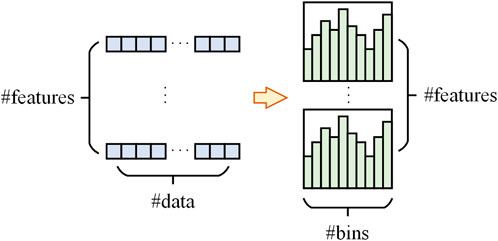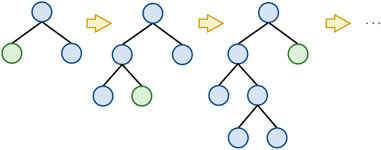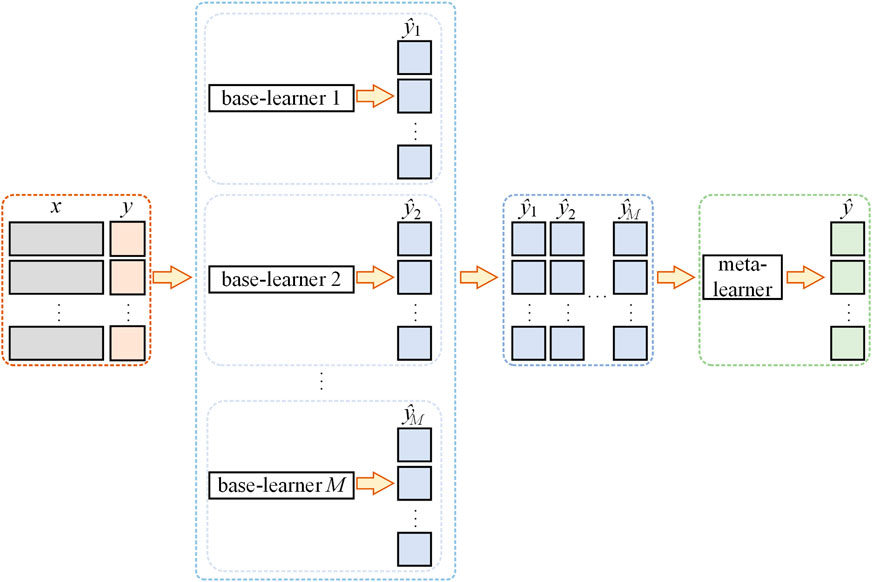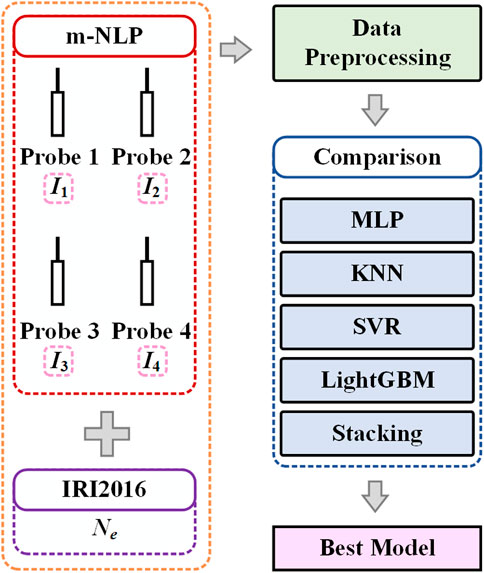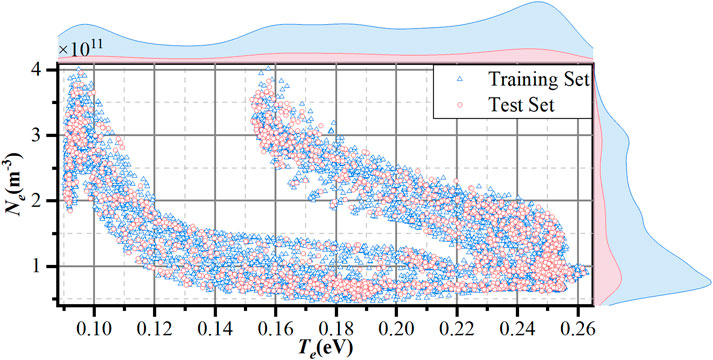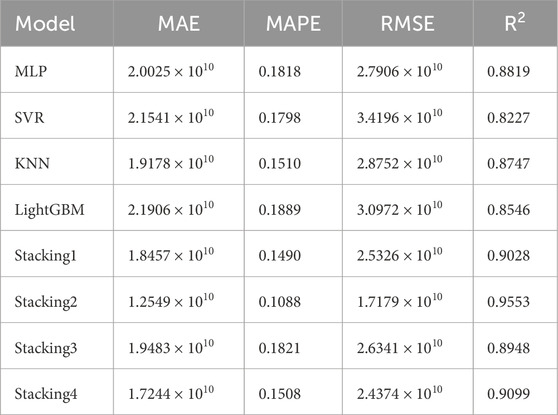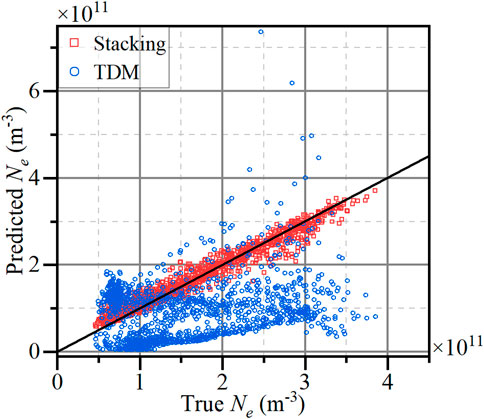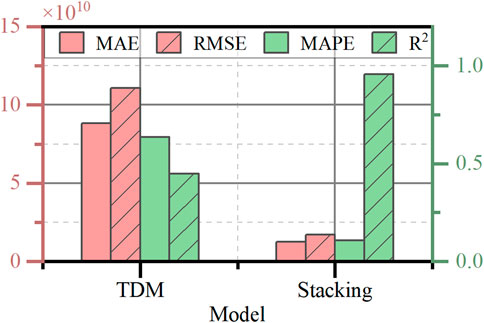- 1State Key Laboratory of Solar Activity and Space Weather, National Space Science Center, Chinese Academy of Sciences, Beijing, China
- 2Weihai Key Laboratory of Microsatellites Payload Development and Geospace Environment Exploration, Institute of Space Sciences, Shandong University, Weihai, China
- 3School of Mechanical, Electrical and Information Engineering, Shandong University, Weihai, China
There are numerous small-scale electron density irregularities in the ionosphere. The coordination of multiple needle Langmuir probes (m-NLPs) enables in situ measurement of electron density with high spatial resolution. However, the theoretical analysis method based on orbital motion-limited (OML) theory cannot accurately estimate electron density, even at higher resolutions, due to limitations in satellite measurements. In addition, due to the influence of satellite charging and flight wake, the currents collected between multi-probes have low consistency, introducing significant error into the measurement results. This study uses a stacking algorithm to process m-NLP data and incorporates the International Reference Ionosphere (IRI) model to correct the predicted electron density (Ne) values. The integrated characteristics of the stacking model make full use of the advantages of various models such as multilayer perceptron (MLP), support vector regression (SVR), K-nearest neighbors (KNN), and light gradient boosting machine (LightGBM). The combination of integrated machine learning methods and IRI models greatly improves the accuracy of electron density measurements obtained by m-NLPs. The results indicate that even with poor consistency among the currents collected by multiple probes, the coefficient of determination (R2) of the prediction results using this method can reach 0.9553, which is 0.5079 higher than that of the traditional diagnostic method.
1 Introduction
There are some plasma clouds with different degrees of ionization in the ionosphere, which are called ionospheric irregularities (Aol et al., 2020; Reid, 1968). Their electron density (Ne) is higher or lower than the average ionization density of the surrounding environment. The spatial-scale distribution of irregularities ranges from meters to several thousand kilometers (Xing et al., 2018). The formation mechanisms and principles of irregularities at different scales are different, and their spatial and temporal evolution is also complex and dynamic. Numerous small-scale irregularities (ranging from meter to hectometer scale) that form at the edges of large- and medium-scale irregularities have been shown to cause severe amplitude and phase scintillation in radio waves. The rapid fading in short–medium waves and forward scattering of very high frequencies cause changes in signal trajectory and propagation delay in radio waves (Ning et al., 2012; Tereshchenko et al., 2006; Liu et al., 2021), leading to adverse effects on satellite communication and GNSS. Thus, it is important to measure the small-scale irregularities in the ionospheric plasma to mitigate their effects on radio wave communication.
Mott-Smith and Langmuir (1926) proposed a Langmuir probe diagnostic method to measure various plasma parameters. Later, this method has been widely used in space plasma exploration (Lebreton et al., 2006; Buchert et al., 2015; Wang et al., 2018; Lee et al., 2013). Traditional Langmuir probe systems rely on active voltage sweeping mechanisms (Lebreton et al., 2006; Fish et al., 2014) to acquire probe current measurements through which current–voltage (I–V) response profiles are derived. These data have been analyzed using theories such as orbital motion-limited (OML) theory (Mott-smith and Langmuir, 1926), the Allen–Boyd–Reynolds (ABR) theory (Allen et al., 1957), and the Bernstein–Rabinowitz–Laframboise (BRL) theory (Bernstein and Rabinowitz, 1959; Chen, 1965) to obtain plasma parameters such as Ne, temperature (Te), and satellite floating potential (Vf) (Liu et al., 2023). The use of Langmuir probes in ionosphere satellites helped measure the distribution of ionospheric irregularities, enhancing our understanding of how ionospheric irregularities affect wireless communication and improving the reliability of modern communication systems.
The Langmuir probe can perform accurate in situ measurement of Ne in ionospheric plasma, which is one of the key parameters of the ionosphere composition and dynamics. The changes in Ne affect many aspects, such as radio communication, radar systems, satellite navigation, and space weather (Kintner and Ledvina, 2005; Chapin et al., 2006; Jakowski et al., 2001; Akala et al., 2012). These plasma irregularities exhibit dynamic spatial configurations that require quantification of Ne at meter to multi-kilometer scales for precise characterization of their spatiotemporal evolution (Kintner and Seyler, 1985). The limited correlation between the scanning frequency and plasma frequency of traditional Langmuir probes implies the difficulty in achieving high spatial resolution.
The new multi-needle Langmuir probe (m-NLP), conceived and engineered by Norway’s University of Oslo, was successfully deployed aboard the NorSat-1 during its orbital insertion from the Baikonur Cosmodrome, Kazakhstan, on 14 July 2017 (Hoang et al., 2018a). NorSat-1 completes dual equatorial traverses and polar transits within its 90-min orbital period. The m-NLP suite integrates a quad-probe configuration with independent bias-voltage control, featuring cylindrical sensors with 0.5 mm diameter and 25 mm axial dimensions. This payload achieves 1 kHz temporal resolution with 1 nA current measurement sensitivity (Hoang et al., 2018a), specifically designed to elucidate the formation mechanisms of small-scale plasma irregularities through high-precision Ne gradient measurements.
Jacobsen et al. (2010) proposed a new approach for the fast computation of Ne, which was later used to process m-NLP data. This method uses multiple fixed-bias Langmuir probes to simultaneously sample the plasma at different biases in the electron saturation region of the I–V characteristic. This method does not need scanning bias voltage or Te at the beginning. The time required to obtain plasma parameters is short, which can greatly improve the spatial resolution of measuring Ne. Hereafter, the Ne calculation method proposed by Jacobsen et al. (2010) using linear fitting will be referred to as the traditional diagnostic method (TDM). Regarding the OML theory, the probe saturation current (Ip) and the applied bias voltage need to satisfy Equation 1 (Allen, 1992):
where e is the electron charge, A is the surface area of the probe, kB is the Boltzmann constant, me is the electron mass, and V is the bias voltage applied by the probe relative to the plasma space potential. In OML theory, the exponential β-value of the cylindrical Langmuir probe is 0.5, which is also used by m-NLP to calculate Ne. However, in practical situations, it is difficult to meet all the prerequisites of OML theory (Ma et al., 2019). For example, the plasma needs to satisfy the conditions such as (1) being collisionless, (2) following a non-drifting Maxwell distribution, (3) being non-magnetized, and (4) having an ion-collected current much smaller than the electron-collected current. It is reasonable to assume that the plasma in the ionosphere satisfies the above conditions. However, the limitations of the probe need to be discussed separately. At first, the potential carried on the probe must satisfy the following condition: (5) eV/kT > 0 or eV/kT ≥ 2 for cylindrical objects. The two requirements for the size of the probe are as follows: (6) the probe must be very thin, meaning that the probe radius r needs to be much smaller than the Debye length (λDe), and (7) for a cylindrical probe, the probe length l needs to be much greater than λDe.
The Langmuir probe payload working in space may not always meet the abovementioned seven conditions, especially (5) and (7). The TDM algorithm based on OML theory assumes a linear relationship between the square of the current collected and the voltage applied by the probe, which forms the basis for excluding Te in calculating Ne. However, this only applies when the bias voltage applied to the probe is higher than the plasma potential, that is, the probe is in the saturation region of the I–V characteristics. However, the potential on the lower-potential probe of the CubeSat spacecraft is usually lower than the plasma potential due to the negative potential carried by the spacecraft (Ma et al., 2019). This prevents the probe from meeting the condition eV/kT ≥ 2, resulting in poor consistency in current collection between several probes and causing significant errors in the TDM results.
In addition, OML has certain requirements for the probe shape such that the probe radius should be smaller than the plasma λDe, while the probe length far exceeds λDe (Ma et al., 2019; Hoskinson and Hershkowitz, 2006). However, probes cannot satisfy this condition in the ionosphere, and in real practice, the probe length is usually similar to or even smaller than λDe (Guthrie et al., 2021; Hoang et al., 2019). For example, the probe length of m-NLP is 25 mm, which, in most cases, is much smaller than the λDe of the ionospheric plasma (ranges from 7 mm to 400 mm). Therefore, taking β directly as 0.5 is inaccurate. Many studies have shown that the value of β varies within a certain range (Jacobsen et al., 2010; Friedrich et al., 2013; Bekkeng et al., 2019; Hoang et al., 2018b). Certain studies also indicate that OML theory cannot be fully satisfied even with a probe length of 50 mm (Hoskinson and Hershkowitz, 2006). However, TDM did not account for errors in the Ne results caused by β deviations from 0.5.
The operational attitude of the spacecraft and contamination of probe surfaces can also lead to significant errors. When a spacecraft flies in low Earth orbit, one or more probes are likely to work within the plasma wake generated by the spacecraft’s movement. Under this orbital dynamics, the thermal motion of ions remains low relative to the platform velocity, while the thermal motion of electrons far exceeds the orbital velocity threshold. However, electrons can only penetrate the ion-rarefied wake region behind the probe within the range allowed by bipolar diffusion (Barjatya et al., 2009). Therefore, the operation of the spacecraft affects the collected current of the Langmuir probe in the ion and electron saturation regions, thus affecting Ne measurements (Ivarsen et al., 2019). Moreover, the surface of Langmuir probes is prone to adsorb water and neutral gas molecules, resulting in a weakened ability to absorb electrons or ions. The different levels of contamination between multiple probes can also cause significant errors.
In summary, due to the lack of many restrictions for the establishment of OML, there is a significant error between Ne provided by m-NLP and the actual observation. Thus, a new method is needed to accurately process the data generated by m-NLP, and this study proposes a method that combines the stacking algorithm in machine learning with m-NLP to estimate ionospheric plasma parameters, which can accurately capture the rapid changes in plasma Ne.
Section 2 introduces the theory of Ne measurement; Section 3 introduces several machine learning methods integrated in this model and the evaluation methods for the final results; Section 4 introduces the specific experimental process and provides a detailed analysis of the experimental results; and Section 5 presents the conclusion.
2 Theory of electron density measurement
Figure 1 shows the representative I–V characteristics collected by the cylindrical Langmuir probe in plasma. The vertical axis shows the current collected by the probe (Ip), and the horizontal axis shows the scanning voltage (Vb) applied by the probe. The characteristic curve can be divided into three regions, namely, the ion saturation region, the transition region, and the electron saturation region, as the bias voltage changes from negative to positive. The voltage corresponding to the boundary point is the plasma floating potential (Vf) and plasma potential (Vp).
Within the ion saturation region, Vb applied to the probe is much lower than Vp, causing it to repel most electrons, and only a very small number of high-energy electrons are captured by the probe’s sheath. Therefore, Ip can be considered to be mainly contributed by ions captured by the probe at this point while neglecting the role of a few electrons. Meanwhile, the negative potential of the probe attracts ions and forms an ion sheath around the probe. The condition of electrical neutrality is not met within the sheath (Ni > Ne), but outside the sheath, the plasma remains electrically neutral and is not disturbed by the probe’s potential. Ions enter the sheath at a random velocity, forming the ion saturation current (Iis) of the probe. The value of the ion saturation current is calculated as shown in Equation 2 for the Bohm current.
where Ni is the ion density and mi is the ion mass. Although Iis is theoretically constant, experimental observation shows that the ion saturation current does not remain fixed as Vb changes; instead, it gradually increases, especially for spherical and cylindrical probes. As Vb increases, the thickness of the sheath also changes, and the positive correlation with the absolute value of Vb results in an increase in the area for collecting ions, and consequently, the ion current does not saturate. Therefore, the ion saturation current cannot be described by the collection theory of planar probes, and at this point, Mott-Smith and Langmuir (1926) proposed OML theory.
OML theory considers the motion path of individual ions at the microscopic level. It is assumed that a positive ion starts at infinity and moves at a velocity v0 along a fixed direction toward a cylindrical Langmuir probe with a radius Rp, as shown in Figure 2. It is also assumed that the plasma potential at infinity is 0, and the probe potential is negative.
In Figure 2, p is the distance between the incident orbit and the center point of the probe, and a is the distance from the center point of the probe after being attracted by the probe voltage and changing the orbit. According to the conservation of energy and angular momentum, if the distance between the ion and the center of the probe is less than Rp, the ion will be absorbed by the probe. Therefore, the ion flux (Φi) of the cylindrical probe with length L can be calculated using Equation 3:
where V0 is the voltage at the starting area of the ion, Va is the voltage at the current area, and Φr is the random flux generated by the ion’s thermal velocity with the same Maxwell energy distribution (Equation 4).
where Ti is the ion temperature. Integrating the distribution function of ions with Maxwell’s velocity distribution yields the total flux (Φ) of the probe, as shown in Equation 5:
where
When the three conditions s >> a, x >> ϕ, and Ti→0 are satisfied, Equation 5 can be approximated using Taylor expansion as
Under orbital motion-limited theory, the relationship between ion saturation current and probe voltage for a cylindrical Langmuir probe can also be extended to calculate the electron saturation current, as shown in Equation 6.
The Ne rapid diagnostic method proposed by Jacobsen et al. (2010) only requires the use of two or more fixed-bias Langmuir probes. When the bias voltage is sufficiently positive, the electron current dominates, resulting in the probe being in the electron saturation current region. Squaring Equation 1 yields Equation 7:
V1 and V2 represent the two different biases of the probe, and Ip1 and Ip2 represent the currents collected by the two probes with different biases. The difference between the squares of two currents yields Equation 8:
From Equation 8, Ne can be obtained as follows:
According to Equation 9, Ne can be calculated for two different biases through the probe and their corresponding collection currents. This suggests that, in the same plasma, the square of the probe collection current shows a linear relationship with the voltage difference, as shown in Figure 3.
To make the results more reliable, bias voltages and corresponding currents are linearly fitted at no less than three points to solve Ne, which greatly improves the spatial resolution of plasma density.
3 Method of ensemble learning
Ensemble learning techniques have achieved state-of-the-art performance in diverse machine learning applications by combining the predictions from two or more base models (Mienye and Sun, 2022). In this study, multilayer perceptron (MLP), support vector regression (SVR), K-nearest neighbors (KNN), and light gradient boosting machine (LightGBM) were used as the base models.
3.1 Multilayer perceptron
MLP is a widely used deep learning model, which is a feedforward network capable of solving linearly inseparable problems. Its structure is shown in Figure 4 (Kruse et al., 2022).
MLP consists of an input layer, several hidden layers, and an output layer containing multiple neurons in each layer. Each neuron receives and processes the output signals of all neurons in the previous layer and outputs them to the next layer. The calculations of each neuron in MLP are independent of each other. The input to a neuron is calculated as weighted sum of the outputs from the previous layer of neurons, added to a bias term. This calculation is shown in Equation 10:
where i represents the ith neuron, l represents the lth layer, N(l-1) represents the number of neurons in the (L-1)th layer, wij(l) represents the weight connecting the jth neuron in the (L-1)th layer to the ith neuron in the (L-1)th layer, aj(l-1) represents the output of the jth neuron in the (L-1)th layer, and bi(l) represents the bias of the ith neuron in the (l-1)th layer. Zi (L) represents the input of the ith neuron in the lth layer.
Activation functions are used in each hidden layer and output layer of MLP to implement nonlinear transformations that enable the network to learn more complex representations and avoid network degradation. The common activation functions include the sigmoid function (Cox, 1958), ReLU function (Krizhevsky et al., 2017), tanh function (Lecun et al., 2002), and softmax function (Bridle, 1990). By inputting zi(l) into the activation function, the output ai(l) of the neuron can be obtained as shown in Equation 11:
3.2 Support vector regression
SVR is a regression application based on the support vector machine (SVM), which establishes the regression process by finding an optimal hyperplane that only considers the edge points around the training set (Smola and Schölkopf, 2004).
Assuming that the input feature xi and the target output yi form a pair of input–output data, f(x) is the output function of this model. To avoid overfitting of the model and improve its generalization ability, a tolerance error ϵ is introduced so that the model does not need to fit all data points. The absolute value of the difference between f(x) and y is acceptable within the tolerance error ϵ. When calculating the loss, only data points outside the tolerance error range are calculated. As shown in Figure 5, a spacing band is constructed with f(x) as the center, with the upper boundary being f(x)+ϵ and the lower boundary being f(x)−ϵ. If |yi − f(xi)|≤ ϵ is satisfied, then the data point is within the interval band and the loss is 0.
The kernel function maps the input features to a high-dimensional feature space and performs linear regression in the high-dimensional linear space to handle nonlinear problems. The commonly used kernel functions include linear kernel, polynomial kernel, Gaussian kernel, and Laplacian kernel.
3.3 K-nearest neighbors
KNN is an instance-based learning method that identifies K samples nearest to a given observation and uses their average to predict the target value. The calculation method of the average value (y’) is shown in Equation 12.
where K is the number of samples and yi is the actual output value of the ith nearest neighbor sample of the predicted point. The core idea of KNN is to use information from surrounding neighbors for prediction. The choice of K value affects the model’s and the smoothness of its prediction. This indicates that a smaller K makes the model more sensitive, while a larger K results in smoother prediction results.
3.4 Light gradient boosting machine
LightGBM is based on a gradient boosting framework with the core ideas of the histogram algorithm, a leaf-wise growth strategy with depth limitation, unilateral gradient sampling, and mutually exclusive feature bundling (Ke et al., 2017).
The histogram algorithm is an efficient decision tree learning algorithm that has a small memory footprint. Unlike traditional algorithms that sort feature values at each split point, the histogram algorithm divides continuous feature values into discrete intervals and finds the optimal split within those intervals. This approach reduces computational complexity while maintaining high accuracy, as shown in Figure 6.
LightGBM uses the leaf-wise growth strategy, as shown in Figure 7. The leaf-wise growth strategy prioritizes splitting the leaf nodes with the highest gain, and the decision tree stops growing at a certain depth. This limits the complexity of the tree and prevents overfitting while ensuring a fast and efficient model speed.
3.5 Stacking theory
Ensemble learning combines multiple learners into a more powerful learner that can combine multiple models with reasonable strategies to achieve higher performance and generalization ability. The three main methods of ensemble learning are bagging, boosting, and stacking (Ribeiro and Dos santos coelho, 2020). As shown in Figure 8, two types of learners in the stacking model are base learners and meta-learners. The base learner is the underlying learner of the stacking model, which is the first-level learner that directly learns from the raw data and generates first-level prediction results. The meta-learner is the top-level learner of the stacking model and acts as a second-order learner, typically represented by a single model instance. The meta-learner integrates and modifies the output of the base-learner to reduce the bias and variance of the model. It can also generate the final prediction results and improve the stability and accuracy of the model.
The stacking model takes the prediction results of multiple different base learners as input and trains a meta-learner. The learners in each layer can be different types of models, such as decision trees, linear models, and neural networks.
The ensemble feature of the stacking model enables the full utilization of the advantages of each base learner, compensates for the shortcomings of individual learners, and reduces the impact of overfitting of a model on specific data. Its advantage is the ability to extract diverse information from data and adapt to various types of data features and task objectives. This model has high diversity and generalization ability, and its architecture is also easy to expand. However, there is often a risk of overfitting in the stacking model when faced with limited input data, so some overfitting strategies must be used during the training process of the model. This study used k-fold cross-validation (k = 5) during both base-learner training and meta-learner stacking. For neural network-based base learners (MLP, etc.), we applied L2 regularization (λ = 0.01) and dropout (rate = 0.2) to reduce model complexity and avoid overfitting.
4 Experimental process and results
The data used in this study come from the m-NLP payload and the IRI 2016 model. The m-NLP provides probe current data required for prediction, while IRI 2016 provides Ne data corresponding to the probe’s data. The NorSat-1 m-NLP data can be downloaded from the data portal website of the University of Oslo (M-nlp, 2024). According to the location and time information provided by the m-NLP, the corresponding Ne data can be obtained from the IRI 2016 model (Bilitza et al., 2014).
IRI 2016 is an international ionospheric reference model developed jointly by the International Committee on Space Research (COSPAR) and the International Union of Radio Science (URSI) to describe the global distribution of key parameters such as Ne, Ni, and Te in the Earth’s ionosphere (Bilitza et al., 2014). IRI 2016 provides standardized and empirical predictions of ionospheric parameters, and the output ionospheric plasma parameters depend on solar activity intensity and the geomagnetic index. Compared to real detection results, the displayed parameters are smoother. However, due to the lack of in situ exploration references in space, this study used the result output by IRI 2016 as reference values. Although there are errors compared with the real ionospheric environment, this study mainly aims to verify the effectiveness of machine learning methods in predicting Ne. IRI 2016 can provide corresponding ionospheric parameters by inputting information such as time and the satellite’s location.
The experimental process is shown in Figure 9. As mentioned earlier, the probe data from the m-NLP and the Ne data from IRI 2016, required for this analysis, can be obtained from their respective websites and together constitute the original dataset. The raw data are then pre-processed, including steps such as filtering and normalization. Finally, we train the single model and the stacking model of various structures subsequently and use the evaluation indicator to compare the prediction effect of each model to determine the best model.
The predictive effectiveness of this model during training can be quantified using evaluation indicators. The evaluation indicators can also identify problems in the model and determine whether overfitting and underfitting have occurred. This analysis chooses mean squared error (MSE) as the loss function given in Equation 13:
where yi is the label value, yi’ is the model’s prediction value, and n is the number of samples. The MSE intuitively measures the squared difference between the predicted and actual values, making the loss function easier to interpret.
The model’s predictive performance is measured using four indicators: mean absolute error (MAE), mean absolute percentage error (MAPE), root mean square error (RMSE), and coefficient of determination (R2).
The MAE can show the actual situation of prediction error and is given in Equation 14:
The MAE provides a quantitative measure to represent the average prediction error size of a model. It measures the average absolute difference between the predicted and true values. Unlike the MSE, the MAE does not assign excessive weight to large errors, suggesting that it is less sensitive to outliers.
The MAPE provides a simple and clear representation of the ratio between the prediction error and true value. The equation for MAPE is shown in Equation 15:
The RMSE function reflects the average error value and can be calculated using Equation 16:
The RMSE has the same unit of measurement error as the raw data. This allows the performance of the model to be understood at the scale of actual observations without being affected by the absolute size of the data. The RMSE is more sensitive to large errors than the MAE, and if the model produces significant errors on some data points, the RMSE will be more pronounced.
R2 can quantify the goodness of fit of a regression model with values spanning from 0 to 1. The closer R2 is to 1, the better the model’s goodness of fit and its explanatory power for changes in the observed values. R2 can be calculated as shown in Equation 17:
where ȳi represents the average of the actual values.
4.1 Data preprocessing
We used m-NLP to obtain probe and satellite orbit data for 5 days, 5 May, 7 May, 8 May, 2 August, and 3 August 2021, which were relatively complete and had high continuity. The longitude, latitude, altitude, and time in m-NLP data can be used to find the corresponding Te and Ne data in IRI 2016. IRI 2016 and m-NLP data were filtered, and some data were removed as some periods of m-NLP data only contained orbital data and did not include probe data. After filtering, there are 1,420 sets of data per day, resulting in a total of 7,100 datasets over 5 days. We combined the four current values of the four probes with the Ne data from IRI 2016 to obtain the raw dataset and divided it into training and testing sets in a 4:1 ratio. The Ne and Te distribution results of the data are shown in Figure 10. The distribution ranges of Ne and Te are 4.65 × 1010 m-3– 4.02 × 1011 m-3 and 0.09 eV–0.26 eV, respectively.
The difference in the dimension of feature vectors can cause the objective function to shift, and normalization is also required between different evaluation indicators. The difference in dimensions can also cause the descent direction to deviate from the minimum value direction and generate violent fluctuations during model gradient descent, ultimately leading to excessively long training time and even ineffective training results. So, we standardize the data before inputting it into the model to eliminate the dimensional influence between various indicators. The zero mean normalization (Equation 18) is a method that can perform linear transformations on data. It can shift the mean of data to 0, help eliminate mean bias, and facilitate model learning of data features.
where μ is the average and σ is the standard deviation of the characteristic values. The zero mean normalization can eliminate mean bias between features by shifting the mean of the data to 0, and this helps the model better capture the relationships between features. The method reduces the bias during the model training process and can accelerate the convergence speed of the model. After standardization, the data present a uniform distribution relative to the center, and optimization algorithms can, thus, quickly find the optimal solution. The zero mean normalization does not change the scale of the data and hence does not affect the feature scale of the model. The standardized data have zero mean and unit variance, which makes the weights of features easier to interpret and reflects their relative contributions to the output.
4.2 Optimizer
The search for the optimal solution is a crucial objective in optimization problems. To achieve this goal, numerous optimization algorithms have been proposed, including the gray wolf optimizer (GWO) (Mirjalili et al., 2014), whale optimization algorithm (WOA) (Mirjalili and Lewis, 2016), and Bayesian optimization (BO) (Frazier and Bayesian optimization, 2018). GWO is a global optimization algorithm inspired by the hierarchical behavior of gray wolf packs, which simulates the social hierarchy and cooperative hunting behavior of gray wolves to search for the optimal solution in the solution space (Mirjalili et al., 2014). WOA is a heuristic global optimization algorithm that mimics the hunting behavior of humpback whales, which primarily consists of three phases: encircling prey, bubble-net attacking, and searching for prey (Mirjalili and Lewis, 2016). BO is a global optimization algorithm designed for optimizing objective functions. It is based on Bayesian inference and Gaussian process modeling, utilizing Gaussian processes to generate a multidimensional Gaussian distribution (Frazier and Bayesian optimization, 2018). By examining the most probable points given by the posterior distribution, BO can identify parameters that yield the global optimum. Through iterative modeling and optimization of the objective function, it locates the optimal solution within a limited number of sampling iterations.
This study used four machine learning models, namely, MLP, SVR, KNN, and LightGBM, and trained and evaluated each model using the three optimizers mentioned above to determine the optimal optimizer suitable for each model. The results are provided in Section 4.4.
4.3 Model construction
The basic idea of the stacking model is to combine the prediction results of various models and leverage their strengths to improve the overall performance of the model. The performance of stacking models obtained by combining different types of models also varies.
Stacking models are divided into homogeneous and heterogeneous stacking models. The basic models of homogeneous stacking are of the same type and have similar structures. Homogeneous stacking models have strong compatibility and simple implementation, but the differences between models are small, making it difficult to fully utilize the characteristics of the models. They are usually suitable for simpler tasks. The basic models of heterogeneous stacking are of different types with significant structural differences.
Heterogeneous stacking models can combine various types of models, such as decision trees, neural networks, and support vector machines, with rich and diverse effects. However, the implementation of this model is relatively complex, and the structure needs to be reasonably matched and attempted. The model is usually suitable for more complex tasks.
This paper uses MLP, SVR, KNN, and LightGBM models to construct a heterogeneous stacking model for Ne prediction. As shown in Table 1, one model is selected from the four models as the meta-learner, and the remaining three models are considered the base learners. The Ne data from IRI 2016 are used as the label values and to train heterogeneous stacking models.
The evaluation indicators of the predictive results of four stacking models and four single models on the test dataset are presented in Table 2 and Figure 11.
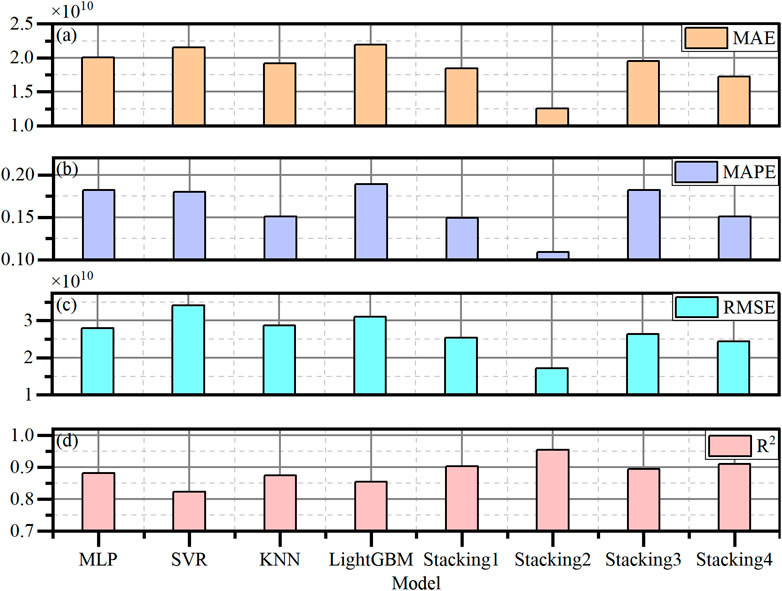
Figure 11. Comparison of evaluation indicators for four independent machine learning models (MLP, SVR, KNN, and LightGBM) and four stacking models with different structures. (a) Mean absolute error. (b) Mean absolute percentage error. (c) Root mean square error. (d) Coefficient of determination.
The predictive results for the test dataset indicate that the SVR model, when used as a meta-learner, has the optimal values for all four evaluation indicators of Ne. It achieves the highest R2 value, reaching 0.9553, and the lowest values for MAE, MAPE, and RMSE, which are 1.2549 × 1010, 0.1088, and 1.7179 × 1010, respectively. Therefore, the SVR model was ultimately selected as the meta-learner for the stacking model, while the MLP, KNN, and LightGBM models were chosen as the base learners, i.e., Stacking2 in Table 1.
4.4 Model parameter
The meta-learner used in this study is SVR, and the optimizer used is the WOA. The base learners are LightGBM, KNN, and MLP. By comparing the three optimization methods (GWO, WOA, and BO), GWO was chosen to optimize them. The main parameters of each optimized model are shown in Table 3.
The main parameters of the SVR model are shown in the first row of Table 3. The parameter 1°C is the penalty parameter that controls the penalty for errors. C is positively correlated with the fitting ability of the model and also represents the probability of overfitting in the model. Gamma is the Gaussian kernel coefficient, which can control the complexity of the model. Gamma is inversely correlated with the smoothness of decision boundaries. Epsilon controls the width of the insensitive interval, and the error within this interval is accepted.
The main parameters of the LightGBM model are shown in the second row of Table 3. The feature_fraction is used to control the proportion of feature sampling used in each iteration, and its value ranges from 0 to 1. This study reduces the risk of overfitting by limiting the number of features used in each iteration while also reducing computational complexity and speeding up model training. When the data dimension is high, the role of feature_fraction is to reduce the impact of dimension disasters. The initial learning rate (base_lr) and final learning rate (final_lr) of the model are 0.0250 and 0.0060, respectively.
The main parameters of the KNN model are shown in the third row of Table 3. The number of neighbors (n_neighbors) needs to be considered when making predictions; a larger number of neighbors results in smoother model performance. The leaf_size is the size of the leaf node.
The main parameters of the MLP model are shown in the fourth row of Table 3. The MLP model used in this study adopts a configuration of one input layer, two hidden layers, and one output layer. The hidden layer nodes contain 50 and 4 nodes, respectively. The activation function used in the model is the ReLU function. The base_lr and final_lr used in the model are 0.0010 and 0.0001, respectively.
4.5 Results and analysis
After the model training is completed, we first select a period of data from m-NLP to compare the results of two methods: the stacking model and TDM, as shown in Figure 12.
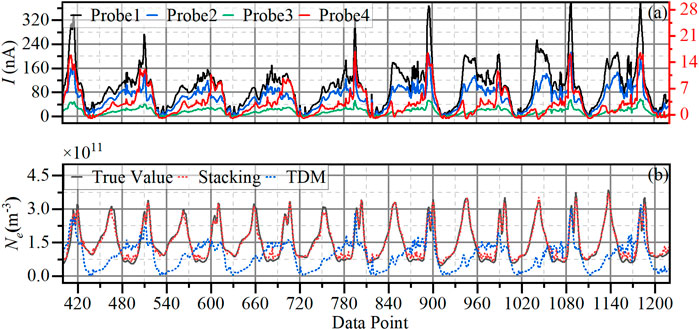
Figure 12. (a) Current collected by four probes of m-NLP. (b) Prediction results of electron density (Ne) of TDM and the stacking model.
The four curves in Figure 12a correspond to the current values of the four probes, and the bias voltages corresponding to the four probes are +10V, +9V, +8V, and +6V. The red curve corresponds to the red coordinate axis on the right side, and the remaining curves correspond to the black coordinate axis on the left side. The curve in Figure 12b represents Ne corresponding to the probe current, while the black solid curve represents the Ne value obtained from IRI 2016 as the true value. The red dashed curve shows the predictive result of the stacking model, and the blue dashed curve shows the Ne diagnostic result of the TDM. The comparison of the results of the two methods is shown in Figure 13, and the distance between the results and the black curve in Figure 13 represents the error.
From Figures 12b, 13, the stacking model’s outcomes outperform TDM in Ne prediction, with TDM yielding consistently lower magnitude results, corroborating the findings of Hoang et al. (2018a). The difference in evaluation indicators between the two approaches is presented in Table 4 and Figure 14.
According to Table 4, the predictive results of the stacking model are significantly better than those of the TDM in terms of evaluation indicators. The error class indicators of the stacking model, such as the MAE, MAPE, and RMSE on the test set data, are significantly lower than those of the TDM. However, the evaluation indicator R2 for the stacking model fit is 0.9553, representing a significant improvement of 0.5079 compared to that of the TDM.
From Figure 12a, the data trends of probes 3 and 4 are significantly different from those of the other probes. This is mainly due to the following reasons:
• The charging effect of the spacecraft causes the voltage applied to one or several probes to be insufficient to bias the probes higher than the plasma potential.
• Pre-launch terrestrial exposure induces surface adsorbate accumulation through atmospheric oxidation processes, altering probe work function characteristics.
• One or more probes work in the plasma wake of the satellite.
• The resolution of m-NLP current measurement is 1 nA, and it has a low signal-to-noise ratio when processing weak signals.
• The probes used in m-NLP cannot satisfy the constraint relationship between the length and the Debye length.
The above reasons affect data acquisition from multiple probes, making the data unsuitable for use with the TDM and leading to certain errors in the final calculation results.
From multiple perspectives, the predictions of the stacking model are significantly better than those of the TDM and can better fit Ne of IRI 2016. This indicates that combining the stacking model with m-NLP for ionospheric plasma prediction can maintain high accuracy, even in the case of poor consistency among the currents collected by multiple probes. This method can achieve an R2 of 0.9553 for Ne prediction results, proving its effectiveness as a data processing approach.
5 Conclusion
A new machine learning method has been proposed to process data from Langmuir multi-probe payloads, such as m-NLP. Due to its unique design, m-NLP can achieve high spatial resolution exploration of ionospheric irregularities, which is of great significance for the study of space weather. Nevertheless, the traditional data analysis method of Langmuir probes based on OML theory cannot be well applied to payloads such as m-NLP. This is mainly due to the following two reasons. First, the sensor used does meet the prerequisites of OML theory. For example, the probe length is significantly smaller than the Debye length, and the potential applied to the probe cannot be higher than the plasma potential. Another aspect that causes errors is the influence of the space environment. For example, the charging effect of the spacecraft creates a large potential barrier between the spacecraft and plasma, and the varying degrees of contamination between multiple probes result in poor consistency in the collection of current by the probes. The above reasons result in significant errors in the measurement of electron density using traditional analysis methods, which cannot meet the requirements for the accurate measurement of plasma.
A stacking algorithm is an integrated machine learning method that combines the prediction results of multiple base models to improve the overall prediction accuracy. It has been applied to multiple physical environments and achieved good results. The new method combines the stacking algorithm with m-NLP data for ionospheric plasma prediction, which can accurately capture the rapid changes in plasma density and help study the small-scale irregularities in the ionosphere for space weather applications. The use of machine learning methods significantly improves the prediction performance of plasma parameters compared to traditional methods based on OML. We compared and analyzed the prediction model using m-NLP data. In the case of poor consistency among the currents collected by multiple probes, the R2 value of this model’s diagnostic results can reach 0.9553, which is 0.5079 higher than that of the traditional diagnostic methods.
Data availability statement
The raw data supporting the conclusions of this article will be made available by the authors, without undue reservation.
Author contributions
JW: Conceptualization, Writing – original draft, Methodology. DZ: Writing – review and editing, Formal Analysis. QZ: Supervision, Writing – review and editing, Funding acquisition. XX: Writing – original draft, Software, Formal Analysis. FZ: Writing – review and editing, Methodology. QD: Supervision, Validation, Writing – review and editing. VM: Writing – review and editing. YS: Investigation, Writing – review and editing.
Funding
The author(s) declare that financial support was received for the research and/or publication of this article. The work was supported by the National Natural Science Foundation of China (grant numbers 42325404 and 42120104003), the China Postdoctoral Science Foundation under grant number 2024M763287, and the Chinese Meridian Project.
Acknowledgments
The authors thank Zhou Yu for providing ideas and valuable discussions for this article.
Conflict of interest
The authors declare that the research was conducted in the absence of any commercial or financial relationships that could be construed as a potential conflict of interest.
Generative AI statement
The author(s) declare that no Generative AI was used in the creation of this manuscript.
Publisher’s note
All claims expressed in this article are solely those of the authors and do not necessarily represent those of their affiliated organizations, or those of the publisher, the editors and the reviewers. Any product that may be evaluated in this article, or claim that may be made by its manufacturer, is not guaranteed or endorsed by the publisher.
References
Akala, A., Doherty, P., Carrano, C., Valladares, C. E., and Groves, K. M. (2012). Impacts of ionospheric scintillations on GPS receivers intended for equatorial aviation applications. Radio Sci. 47 (04), 1–11. doi:10.1029/2012rs004995
Allen, J. E., Boyd, R. L. F., Reynolds, P., et al. (1957). The collection of positive ions by a probe immersed in a plasma; proceedings of the proceedings of the physical society section B, F.
Allen, J. J. P. S. (1992). Probe theory-the orbital motion approach. Phys. Scr. 45 (5), 497–503. doi:10.1088/0031-8949/45/5/013
Aol, S., Buchert, S., and Jurua, E. (2020). Ionospheric irregularities and scintillations: a direct comparison of in situ density observations with ground-based L-band receivers. Earth, Planets Space 72 (1), 164. doi:10.1186/s40623-020-01294-z
Barjatya, A., Swenson, C. M., Thompson, D. C., and Wright, K. H. (2009). Invited article: data analysis of the floating potential measurement unit aboard the international space station. Rev. Sci. Instrum. 80 (4), 041301. doi:10.1063/1.3116085
Bekkeng, T. A., Helgeby, E. S., Pedersen, A., Trondsen, E., Lindem, T., and Moen, J. I. (2019). Multi-needle langmuir probe system for electron density measurements and active spacecraft potential control on CubeSats. IEEE Trans. Aerosp. Electron. Syst. 55 (6), 2951–2964. doi:10.1109/taes.2019.2900132
Bernstein, I. B., and Rabinowitz, I. N. (1959). Theory of electrostatic probes in a low-density plasma. Phys. Fluids 2 (2), 112–121. doi:10.1063/1.1705900
Bilitza, D., Altadill, D., Zhang, Y., Mertens, C., Truhlik, V., Richards, P., et al. (2014). The international reference ionosphere 2012 – a model of international collaboration. J. Space Weather Space Clim. 4, A07. doi:10.1051/swsc/2014004
Bridle, J. S. (1990). “Probabilistic interpretation of feedforward classification network outputs, with relationships to statistical pattern recognition,” in Neurocomputing: algorithms, architectures and applications. Springer, 227–236.
Buchert, S., Zangerl, F., Sust, M., André, M., Eriksson, A., Wahlund, J., et al. (2015). SWARM observations of equatorial electron densities and topside GPS track losses. Geophys Res. Lett. 42 (7), 2088–2092. doi:10.1002/2015gl063121
Chapin, E., Chan, S. F., Chapman, B. D., Chen, C. W., Martin, J. M., Michel, T. R., et al. (2006). “Impact of the ionosphere on an L-band space based radar,” in proceedings of the 2006 IEEE Conference on Radar (IEEE).
Chen, F. F. (1965). Numerical computations for ion probe characteristics in a collisionless plasma. J. Nucl. Energy Part C, Plasma Phys. Accel. Thermonucl. Res. 7 (1), 47–67. doi:10.1088/0368-3281/7/1/306
Cox, D. R. (1958). The regression analysis of binary sequences. J. R. Stat. Soc. Ser. B Stat. Methodol. 20 (2), 215–232. doi:10.1111/j.2517-6161.1958.tb00292.x
Fish, C., Swenson, C., Crowley, G., Barjatya, A., Neilsen, T., Gunther, J., et al. (2014). Design, development, implementation, and on-orbit performance of the dynamic ionosphere CubeSat experiment mission. Space Sci. Rev. 181, 61–120. doi:10.1007/s11214-014-0034-x
Frazier, P. I. (2018). “Bayesian optimization.” Recent advances in optimization and modeling of contemporary problems. Catonsville: Informs, 255–278.
Friedrich, M., Torkar, K. M., Hoppe, U. P., Bekkeng, T. A., Barjatya, A., and Rapp, M. (2013). Multi-instrument comparisons of D-region plasma measurements. Ann. Geophys. 31 (1), 135–144. doi:10.5194/angeo-31-135-2013
Guthrie, J., Marchand, R., Marholm, S., et al. (2021). Inference of plasma parameters from fixed-bias multi-needle langmuir probes (m-NLP). Meas. Sci. Technol. 32 (9), 095906. doi:10.1088/1361-6501/abf804
Hoang, H., Clausen, L. B. N., Røed, K., Bekkeng, T. A., Trondsen, E., Lybekk, B., et al. (2018a). The multi-needle langmuir probe system on board NorSat-1. Space Sci. Rev. 214(4), 75. doi:10.1007/s11214-018-0509-2
Hoang, H., RøED, K., Bekkeng, T. A., Moen, J. I., Clausen, L. B. N., Trondsen, E., et al. (2019). The multi-needle langmuir probe instrument for QB50 mission: case studies of Ex-Alta 1 and hoopoe satellites. 215: 1–19. doi:10.1007/s11214-019-0586-x
Hoang, H., RøED, K., Bekkeng, T. A., Moen, J. I., Spicher, A., Clausen, L. B. N., et al. (2018b). A study of data analysis techniques for the multi-needle langmuir probe. Meas. Sci. Technol. 29(6): 065906. doi:10.1088/1361-6501/aab948
Hoskinson, A., and Hershkowitz, N. (2006). Effect of finite length on the current–voltage characteristic of a cylindrical langmuir probe in a multidipole plasma chamber. Plasma Sources Sci. Technol. 15 (1), 85–90. doi:10.1088/0963-0252/15/1/013
Ivarsen, M. F., Hoang, H., Yang, L., Clausen, L. B. N., Spicher, A., Jin, Y., et al. (2019). Multineedle langmuir probe operation and acute probe current susceptibility to spacecraft potential. IEEE Trans. Plasma Sci.. 47(8): 3816–3823. doi:10.1109/TPS.2019.2906377
Jacobsen, K., Pedersen, A., Moen, J., and Bekkeng, T. A. (2010). A new langmuir probe concept for rapid sampling of space plasma electron density. Meas. Sci. Technol. 21 (8), 085902. doi:10.1088/0957-0233/21/8/085902
Jakowski, N., Wehrenpfennig, A., Heise, S., Schlueter, S., and Noack, T. (2001). “Space weather effects in the ionosphere and their impact on positioning,” in Proceedings of the ESA workshop paper, F.
Ke, G., Meng, Q., Finley, T., Wang, T., Chen, W., Ma, W., et al. (2017). Lightgbm: a highly efficient gradient boosting decision tree. Adv. neural Inf. Process. Syst., 30.
Kintner, P. M., and Ledvina, B. M. (2005). The ionosphere, radio navigation, and global navigation satellite systems. AdSpR 35 (5), 788–811. doi:10.1016/j.asr.2004.12.076
Kintner, P. M., and Seyler, C. E. (1985). The status of observations and theory of high latitude ionospheric and magnetospheric plasma turbulence. Space Sci. Rev. 41 (1), 91–129. doi:10.1007/bf00241347
Krizhevsky, A., Sutskever, I., and Hinton, G. E. (2017). ImageNet classification with deep convolutional neural networks. Commun. ACM. 60 (6), 84–90. doi:10.1145/3065386
Kruse, R., Mostaghim, S., Borgelt, C., Braune, C., and Steinbrecher, M. (2022). Multi-layer perceptrons [M]. Computational intelligence: a methodological introduction. Springer, 53–124.
Lebreton, J.-P., Stverak, S., Travnicek, P., Maksimovic, M., Klinge, D., Merikallio, S., et al. (2006). The ISL langmuir probe experiment processing onboard DEMETER: scientific objectives, description and first results. Planet. Space Sci. Instrum. 54 (5), 472–486. doi:10.1016/j.pss.2005.10.017
Lecun, Y., Bottou, L., Orr, G. B., and Müller, K.-R. (2002). Efficient backprop [M]. Neural networks: tricks of the trade. Springer, 9–50.
Lee, J. C., Min, K. W., Ham, J., Kim, H., and Hong, S. (2013). Langmuir probe experiments on Korean satellites. CAP 13 (5), 846–849. doi:10.1016/j.cap.2012.12.011
Liu, G., Marholm, S., Eklund, A. J., Clausen, L., and Marchand, R. (2023). m-NLP inference models using simulation and regression techniques. J. Geophys. Res. Space Phys. 128 (2), e2022JA030835. doi:10.1029/2022ja030835
Liu, Y., Zhou, C., Xu, T., Tang, Q., Deng, Z., Chen, G., et al. (2021). Review of ionospheric irregularities and ionospheric electrodynamic coupling in the middle latitude region. EARTH Planet. Phys. 5 (5), 1–21. doi:10.26464/epp2021025
Marholm, S., Marchand, R., Darian, D., Miloch, W. J., and Mortensen, M. (2019). Impact of miniaturized fixed-bias multineedle langmuir probes on cubesats. ITPS 47 (8), 3658–3666. doi:10.1109/tps.2019.2915810
Mienye, I. D., and Sun, Y. (2022). A survey of ensemble learning: concepts, algorithms, applications, and prospects. IEEE Access 10, 99129–99149. doi:10.1109/access.2022.3207287
Mirjalili, S., and Lewis, A. (2016). The whale optimization algorithm. Adv. Eng. Softw. 95, 51–67. doi:10.1016/j.advengsoft.2016.01.008
Mirjalili, S., Mirjalili, S. M., and Lewis, A. (2014). Grey wolf optimizer. Adv. Eng. Softw. 69 (3), 46–61. doi:10.1016/j.advengsoft.2013.12.007
Mott-Smith, H. M., and Langmuir, I. (1926). The theory of collectors in gaseous discharges. Phys. Rev. 28 (4), 727–763. doi:10.1103/physrev.28.727
Ning, B., Hu, L., Li, G., Liu, L., and Wan, W. (2012). The first time observations of low-latitude ionospheric irregularities by VHF radar in Hainan. Sci. China Technol. Sci. 55, 1189–1197. doi:10.1007/s11431-012-4800-2
Reid, G. C. (1968). The formation of small-scale irregularities in the ionosphere. J. Geophys Res. 73 (5), 1627–1640. doi:10.1029/ja073i005p01627
Ribeiro, M. H. D. M., and Dos Santos Coelho, L. (2020). Ensemble approach based on bagging, boosting and stacking for short-term prediction in agribusiness time series. Appl. soft Comput. 86, 105837. doi:10.1016/j.asoc.2019.105837
Smola, A. J., and SchöLKOPF, B. (2004). A tutorial on support vector regression. Stat. Comput. 14, 199–222. doi:10.1023/B:STCO.0000035301.49549.88
Tereshchenko, E., Khudukon, B., Rietveld, M., Isham, B., Hagfors, T., and Brekke, A. (2006). “The relationship between small-scale and large-scale ionospheric electron density irregularities generated by powerful HF electromagnetic waves at high latitudes,” in Proceedings of the AnGeo, F (Germany: Copernicus Publications Göttingen).
University of Olso (2024). NorSat-1 multi-needle langmuir probe data. Available online at: http://tid.uio.no/plasma/norsat/index.html (Accessed March 20, 2024).
Wang, X., Samaniego, J., Hsu, H. W., Horányi, M., Wahlund, J., Ergun, R. E., et al. (2018). Development of a double hemispherical probe for improved space plasma measurements. J. Geophys. Res. Space Phys. 123 (4), 2916–2925. doi:10.1029/2018ja025415
Keywords: Langmuir probe, stacking, machine learning, plasma diagnosis, ionospheric irregularity
Citation: Wang J, Zhang D, Zhang Q, Xie X, Zou F, Du Q, Manu V and Sun Y (2025) Stacking data analysis method for Langmuir multi-probe payload. Front. Astron. Space Sci. 12:1614225. doi: 10.3389/fspas.2025.1614225
Received: 18 April 2025; Accepted: 16 July 2025;
Published: 13 August 2025.
Edited by:
Reetesh Kumar Gangwar, Indian Institute of Technology Tirupati, IndiaReviewed by:
Vikram Khaire, Indian Institute of Space Science and Technology, IndiaNishant Sirse, IPS Academy, India
Copyright © 2025 Wang, Zhang, Zhang, Xie, Zou, Du, Manu and Sun. This is an open-access article distributed under the terms of the Creative Commons Attribution License (CC BY). The use, distribution or reproduction in other forums is permitted, provided the original author(s) and the copyright owner(s) are credited and that the original publication in this journal is cited, in accordance with accepted academic practice. No use, distribution or reproduction is permitted which does not comply with these terms.
*Correspondence: Jin Wang, d2FuZ2ppbkBuc3NjLmFjLmNu; Qinghe Zhang, emhhbmdxaW5naGVAbnNzYy5hYy5jbg==
 Jin Wang
Jin Wang Duan Zhang
Duan Zhang Qinghe Zhang1,2*
Qinghe Zhang1,2* V. Manu
V. Manu Yanjv Sun
Yanjv Sun